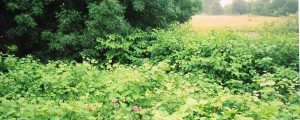You know the type – the one that sneaks up out of nowhere, starts throwing their weight around, too tough to take in hand and then casts a shadow on everything, yes we’re talking about Japanese Knotweed.

The ecological bully, Japanese Knotweed lies in wait underground over the winter months, then as summer approaches and gardeners await the colours of the season it springs up, laying its tough roots across flower beds, gardens and even bursting through paving, walls and floorboards if left to spread.
This weed is a serious tough cookie, in fact Japanese Knotweed is so difficult to control it is included in anti-social behaviour laws. If nature dealt out anti-social behaviour orders this weed would be subject to some serious banning orders.
As it is lawmakers have taken steps to protect property owners from the reaches of Japanese Knotweed’s grasping roots. Owing to its potential to damage buildings and kill native plants, environmental authorities have the right to access property where owners have failed to tackle a Japanese Knotweed outbreak – they can also face a fine if they fail to adhere to an order to control the weed.
Why is Japanese Knotweed such a problem?
With its tall canes and decorative leaves, Japanese Knotweed does not fit the traditional image of a garden weed and was introduced to the UK as a decorative plant in the late 1800s. However, appearances can be deceptive. Japanese Knotweed:
- Grows aggressively from even the smallest root
- Can grow through tarmac and concrete – including buildings and roads
- Overwhelms other garden plants
- Can harm the eco-system by pushing out other plant species
- Can affect the value of a property
What can be done to tackle Japanese Knotweed?
In case you are panicking, it is not illegal to grow Japanese Knotweed. Gardeners must, however, take responsibility for keeping it under control. To do this, gardeners need to display great vigilance.
In the event of discovering Japanese Knotweed on your property the most sensible course of action is to call in professional gardening and weed-killing specialists, such as Gardenbusters.
Outbreaks of Japanese Knotweed can be treated with chemical weedkillers, to ensure the plant does not return this may require repeat treatments.
Japanese Knotweed can also be physically removed, but with roots stretching as far down as three metres and covering wide areas this is no easy task.
In both instances, treatment with either herbicides or physical removal, it is important that no part of the plant remains in the area and that parts of the plant do not splinter off as the smallest piece of Japanese Knotweed can take root to spark another outbreak.
Specialists may also recommend stem injection, burning or burying the weed. Whatever method is used, the plant must be disposed of according to strict regulations to prevent further spread of Japanese Knotweed.
Don’t let this ant-social menace affect your property, take Japanese Knotweed in hand by calling in the experts today – contact Gardenbusters for a free quote.








